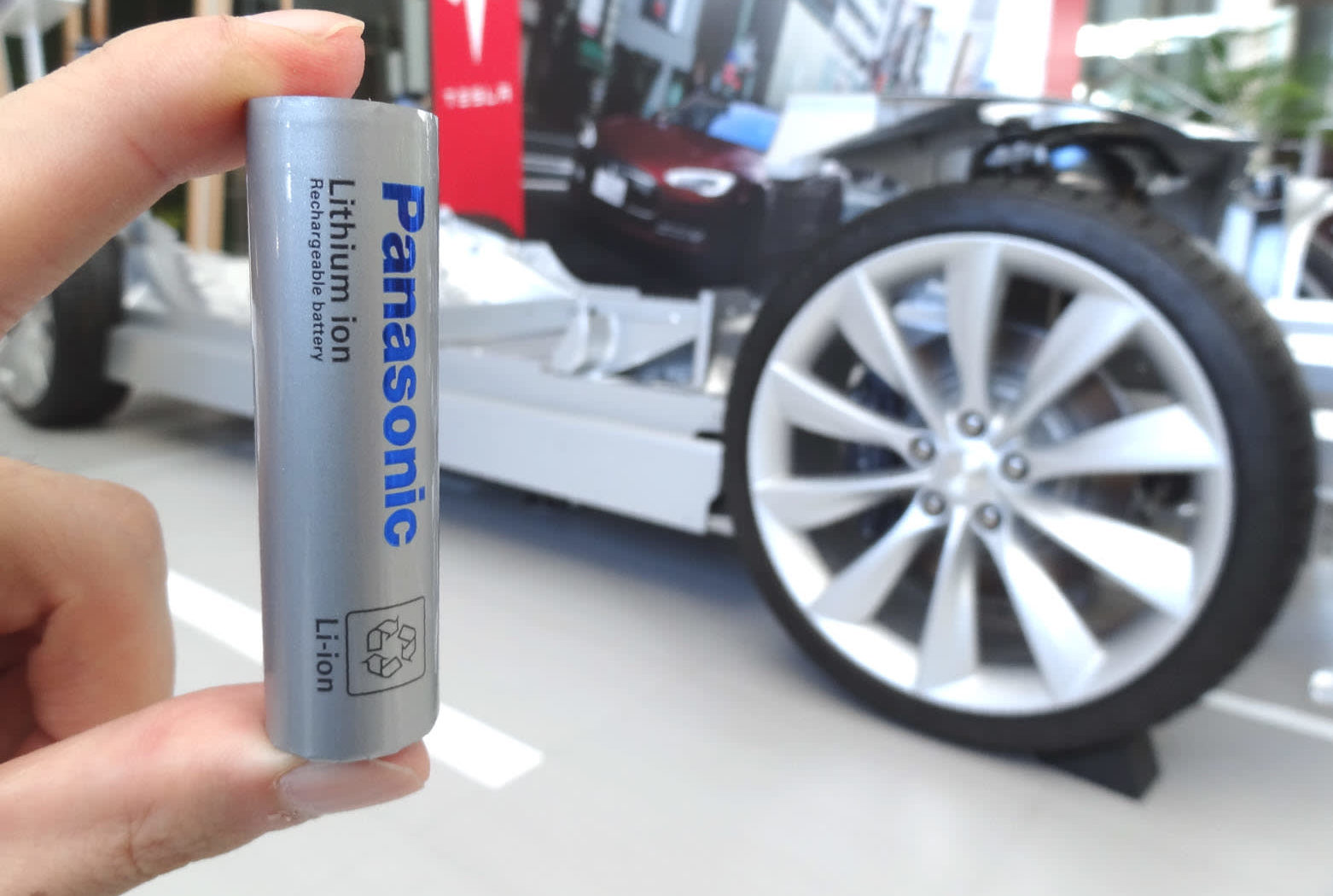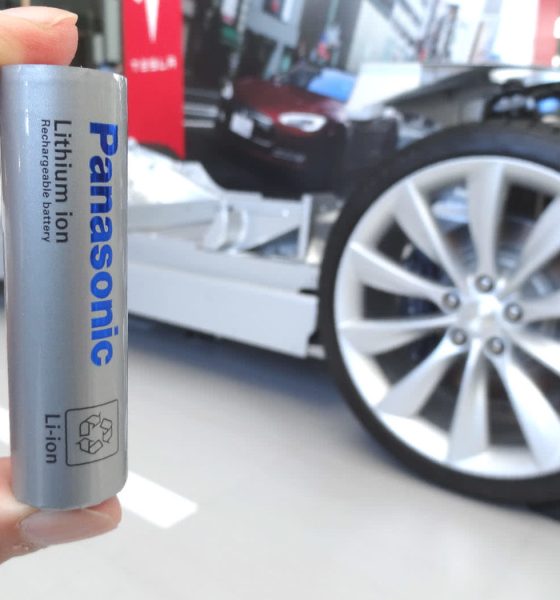

Investor's Corner
Tesla’s battery business expected to contribute to Panasonic’s profit starting October
Tesla’s exclusive battery supplier and partner Panasonic Corp announced on Tuesday that its fiscal first-quarter net profit saw an increase of 17.6% due to growth in its automotive-related business. Panasonic saw its net profits from April to June rise 17.6% to 57.4 billion yen ($515 million), up 15% from last year’s 48.8 billion yen ($440 million).
The Japanese battery maker and tech company credits the emerging market for clean energy vehicles as one of the key factors behind its profit increase during the first quarter of the fiscal year. In a briefing on Tuesday, Chief Financial Officer Hirokazu Umeda stated that Panasonic’s battery business with Tesla could contribute to the Japanese company’s profit starting October, thanks to the American carmaker’s ongoing production ramp of the Model 3 sedan.
“Production at Tesla is gaining momentum. We are ramping up a new battery production line now and expect the business to contribute not just to our revenue but also to our profit from the second half starting in October,” the Panasonic CFO said.
Being the exclusive battery provider for Tesla’s electric cars and energy products, Panasonic has experienced firsthand the “production hell” and bottlenecks that surrounded the American carmaker’s Model 3 ramp. During Tesla’s burst production week at the end of June alone, Panasonic reportedly had to convert cells intended for Tesla’s energy storage products to battery packs for the Model 3.
As Tesla aims to sustain its production rate for the Model 3, Panasonic is looking to add three new battery cell production lines at Gigafactory 1, which would allow the company to support the Model 3 ramp. Panasonic expects its battery output from Gigafactory 1 to increase by 30% with the addition of the three new lines. Yoshio Ito, the chief of Panasonic’s automotive business, also stated last month that the Japanese battery maker would consider additional investment in Tesla’s Gigafactory 1 if needed.
With Tesla’s target of building 5,000 Model 3 per week being met at the end of Q2 2018, it is now up to the electric car maker to prove that it can sustain its optimal level of the production from Q3 moving forward. If Tesla Senior Director of Investor Relations Aaron Chew’s meeting with investors and analysts last month is any indication, however, it appears that Tesla is looking to adopt a more gradual ramp for the Model 3 in the following quarters. During the meeting, Chew reportedly stated that Tesla is targeting a sustained production rate of 5,000-6,000 Model 3 per week in Q3, followed by an increase to 7,000 units per week on Q4 2018 and an even more gradual ramp to 10,000 vehicles per week by mid-2019.
Considering Tesla’s goals for the Model 3 and its plans to ramp the manufacturing of its residential energy products, Panasonic’s three additional production lines at Gigafactory 1 could very well be the tip of the iceberg in a long line of additional investments for the Nevada facility. After all, if there’s anything that the electric car maker proved during the end of Q2 2018, it is the fact that while its growth has been significant over the years, it is only getting started. As Tesla’s partner, Panasonic has to prove that it can adapt and ramp at the breakneck pace that the electric car maker has exhibited over the years.

Investor's Corner
Tesla stock closes at all-time high on heels of Robotaxi progress

Tesla stock (NASDAQ: TSLA) closed at an all-time high on Tuesday, jumping over 3 percent during the day and finishing at $489.88.
The price beats the previous record close, which was $479.86.
Shares have had a crazy year, dipping more than 40 percent from the start of the year. The stock then started to recover once again around late April, when its price started to climb back up from the low $200 level.
This week, Tesla started to climb toward its highest levels ever, as it was revealed on Sunday that the company was testing driverless Robotaxis in Austin. The spike in value pushed the company’s valuation to $1.63 trillion.
Tesla Robotaxi goes driverless as Musk confirms Safety Monitor removal testing
It is the seventh-most valuable company on the market currently, trailing Nvidia, Apple, Alphabet (Google), Microsoft, Amazon, and Meta.
Shares closed up $14.57 today, up over 3 percent.
The stock has gone through a lot this year, as previously mentioned. Shares tumbled in Q1 due to CEO Elon Musk’s involvement with the Department of Government Efficiency (DOGE), which pulled his attention away from his companies and left a major overhang on their valuations.
However, things started to rebound halfway through the year, and as the government started to phase out the $7,500 tax credit, demand spiked as consumers tried to take advantage of it.
Q3 deliveries were the highest in company history, and Tesla responded to the loss of the tax credit with the launch of the Model 3 and Model Y Standard.
Additionally, analysts have announced high expectations this week for the company on Wall Street as Robotaxi continues to be the focus. With autonomy within Tesla’s sights, things are moving in the direction of Robotaxi being a major catalyst for growth on the Street in the coming year.
Elon Musk
Tesla needs to come through on this one Robotaxi metric, analyst says
“We think the key focus from here will be how fast Tesla can scale driverless operations (including if Tesla’s approach to software/hardware allows it to scale significantly faster than competitors, as the company has argued), and on profitability.”

Tesla needs to come through on this one Robotaxi metric, Mark Delaney of Goldman Sachs says.
Tesla is in the process of rolling out its Robotaxi platform to areas outside of Austin and the California Bay Area. It has plans to launch in five additional cities, including Houston, Dallas, Miami, Las Vegas, and Phoenix.
However, the company’s expansion is not what the focus needs to be, according to Delaney. It’s the speed of deployment.
The analyst said:
“We think the key focus from here will be how fast Tesla can scale driverless operations (including if Tesla’s approach to software/hardware allows it to scale significantly faster than competitors, as the company has argued), and on profitability.”
Profitability will come as the Robotaxi fleet expands. Making that money will be dependent on when Tesla can initiate rides in more areas, giving more customers access to the program.
There are some additional things that the company needs to make happen ahead of the major Robotaxi expansion, one of those things is launching driverless rides in Austin, the first city in which it launched the program.
This week, Tesla started testing driverless Robotaxi rides in Austin, as two different Model Y units were spotted with no occupants, a huge step in the company’s plans for the ride-sharing platform.
Tesla Robotaxi goes driverless as Musk confirms Safety Monitor removal testing
CEO Elon Musk has been hoping to remove Safety Monitors from Robotaxis in Austin for several months, first mentioning the plan to have them out by the end of 2025 in September. He confirmed on Sunday that Tesla had officially removed vehicle occupants and started testing truly unsupervised rides.
Although Safety Monitors in Austin have been sitting in the passenger’s seat, they have still had the ability to override things in case of an emergency. After all, the ultimate goal was safety and avoiding any accidents or injuries.
Goldman Sachs reiterated its ‘Neutral’ rating and its $400 price target. Delaney said, “Tesla is making progress with its autonomous technology,” and recent developments make it evident that this is true.
Investor's Corner
Tesla gets bold Robotaxi prediction from Wall Street firm
Last week, Andrew Percoco took over Tesla analysis for Morgan Stanley from Adam Jonas, who covered the stock for years. Percoco seems to be less optimistic and bullish on Tesla shares, while still being fair and balanced in his analysis.

Tesla (NASDAQ: TSLA) received a bold Robotaxi prediction from Morgan Stanley, which anticipates a dramatic increase in the size of the company’s autonomous ride-hailing suite in the coming years.
Last week, Andrew Percoco took over Tesla analysis for Morgan Stanley from Adam Jonas, who covered the stock for years. Percoco seems to be less optimistic and bullish on Tesla shares, while still being fair and balanced in his analysis.
Percoco dug into the Robotaxi fleet and its expansion in the coming years in his latest note, released on Tuesday. The firm expects Tesla to increase the Robotaxi fleet size to 1,000 vehicles in 2026. However, that’s small-scale compared to what they expect from Tesla in a decade.
Tesla expands Robotaxi app access once again, this time on a global scale
By 2035, Morgan Stanley believes there will be one million Robotaxis on the road across multiple cities, a major jump and a considerable fleet size. We assume this means the fleet of vehicles Tesla will operate internally, and not including passenger-owned vehicles that could be added through software updates.
He also listed three specific catalysts that investors should pay attention to, as these will represent the company being on track to achieve its Robotaxi dreams:
- Opening Robotaxi to the public without a Safety Monitor. Timing is unclear, but it appears that Tesla is getting closer by the day.
- Improvement in safety metrics without the Safety Monitor. Tesla’s ability to improve its safety metrics as it scales miles driven without the Safety Monitor is imperative as it looks to scale in new states and cities in 2026.
- Cybercab start of production, targeted for April 2026. Tesla’s Cybercab is a purpose-built vehicle (no steering wheel or pedals, only two seats) that is expected to be produced through its state-of-the-art unboxed manufacturing process, offering further cost reductions and thus accelerating adoption over time.
Robotaxi stands to be one of Tesla’s most significant revenue contributors, especially as the company plans to continue expanding its ride-hailing service across the world in the coming years.
Its current deployment strategy is controlled and conservative to avoid any drastic and potentially program-ruining incidents.
So far, the program, which is active in Austin and the California Bay Area, has been widely successful.








